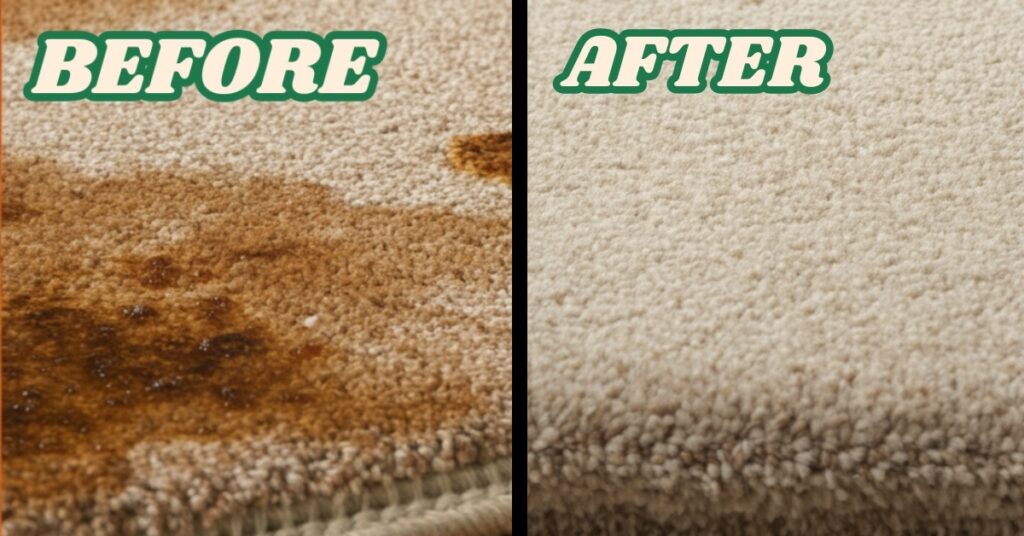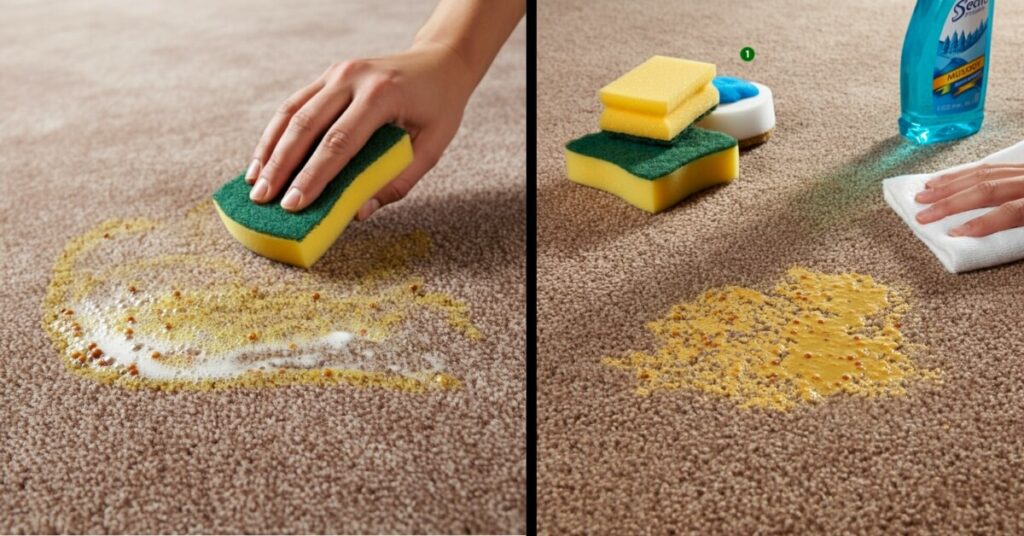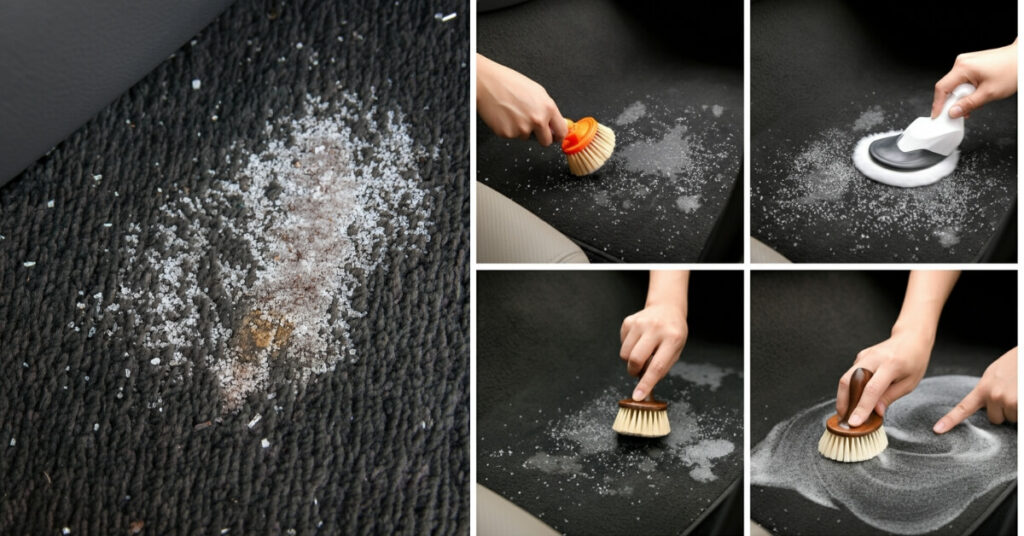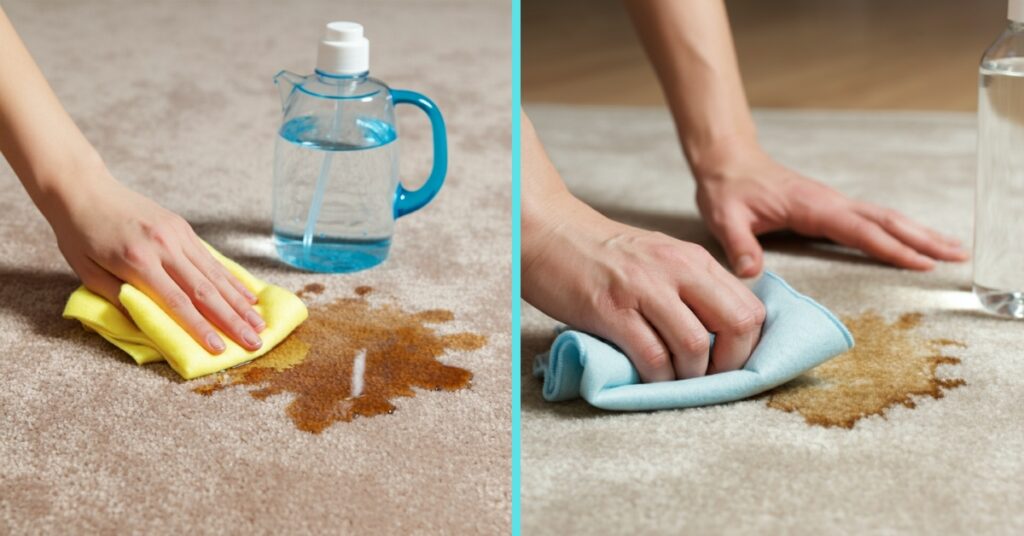As an Amazon Associate, I earn from qualifying purchases.
Accidental oil spills on carpet can ruin any good day, maybe you splattered frying oil while cooking, dripped driveway motor oil from your shoes, or tipped a bottle of olive oil while plating dinner. Unlike juice or coffee, oil creeps down into the carpet fibers and leaves a greasy, dark spot that attracts pet hair and funky smells. The good news is that with the right steps to remove oil stains on carpet, those pesky spots can vanish for good, protecting your carpet and your home.
In this guide, you’ll find quick and effective methods for getting oil stains out. We’ll cover homemade solutions you can whip up from pantry items, as well as ready-made cleaners you can grab at the store. By the time you’re finished reading, you’ll have the know-how and confidence to beat oil stains on any type of carpet.
Why Oil Stains on Carpet Are So Hard to Get Out?
Oil stains are some of the toughest messes to deal with, and here’s why:

Sinking In
Oil doesn’t just pool on top; it seeps right into the fibers and padding below. Once it’s lodged in there, especially if it’s dried or walked on, it’s like the stain is anchoring itself and refusing to budge.
Sticky Grip
Oil loves to stick, and it clings to carpet fibers like super glue. If you don’t tackle it right away, that strong bond can cause the color to fade weirdly and leave a residue that never seems to wash out.
Grime Magnet
Even a tiny smear can leave a slick spot that attracts dirt like a magnet. What starts small can expand into a bigger stain that keeps getting darker every time someone steps on it.
Funky Smell
Certain oils, like cooking or motor oil, come with an odor that’s just as bothersome as the stain. So you can’t just scrub the color out; you have to deal with the smell, too. Because oil stains have all these tricks, the best plan is to jump on them fast and use the right methods to save your carpet from permanent damage.
How to Get Oil Stains Out of Carpet (Step-by-Step)
Fast action is best, but if the stain’s already a few days old, this guide can still help you make a big difference.
Step 1: Blot the Stain
Catch the stain quick, and it’ll be easier to deal with. Here’s how to start:
- Blot, Don’t Rub: Grab a clean, dry cloth or paper towel and gently press straight down on the stain. Rubbing will only push the oil farther down or make it spread, which we don’t want.
- Add a Little Pressure: For a big spill, cover the stain with a paper towel and press down gently, or set something flat and heavy, like a thick book, on it. This will help soak up more oil.
- Keep Blotting: Swap out the cloth or towel every time it gets oily and keep blotting until it no longer picks up any more oil. The goal is to lift it out, not spread it.
Step 2: Apply an Absorbent
Once you’ve blotted, it’s time to lift the oil with something that soaks it up. Baking soda and cornstarch work wonders.
- Choose Your Absorbent: Grab baking soda or cornstarch and sprinkle a thick layer over the stain. Make sure every speck is covered.
- Let It Sit: Give it at least 15–20 minutes, but 1 hour or even longer is better for tougher stains. If you’re dealing with an old oil mark, let the powder sit overnight for the best shot at lifting it out.
Vacuum Again
Give the area one more pass with the vacuum. A vacuum with strong suction will pull out leftover powder and any loosened oil. Focus on the edges of the stain, where gunk tends to linger. If you have a hose attachment, use it to get into the carpet fibers. You might be surprised how much more oily powder it lifts.
Step 3: Use Dish Soap or Carpet Cleaner
To tackle any sticky bits, grab either a trusty dish soap or a carpet cleaner. Both can cut through grease when oil and powder hang around.
Option A: Dish Soap Solution
- Mix the Solution: Stir together 1 tablespoon of a grease-cutting dish soap, like Dawn, with 2 cups of warm water.
- Apply Gently: Soak a clean cloth in the mix and dab it on the stain. Don’t flood the spot—too much water can reach the carpet pad and slow down drying.
- Blot and Rinse: Switch to a fresh cloth dampened with plain water and press it on the area to lift out the soap. Keep rinsing until the carpet feels clean, not sticky or stiff. For big or old stains, you might need to repeat a few times.
Option B: Carpet Cleaner
Store-bought carpet cleaners made for grease contain special enzymes or solvents that tackle oil stains more easily.
- Recommended Products: Look for Resolve Carpet Cleaner Spray or Bissell Professional Pet Carpet Cleaner. Always read the label for instructions, and test the product in a hidden spot first to be safe.
- Pro Tip: Got a carpet cleaning machine? Pick a cleaning solution made for your machine, then spray it right on the stain for a deeper clean.
Step 4: Rinse and Dry Right
Don’t skip the rinse! Extra soap left behind can grab dirt and make new stains pop up.
- Rinse: Use a clean cloth dipped in plain water. Dab the spot and repeat until you see no more bubbles.
- Dry: Press a dry towel onto the spot, then turn on a fan or crack a window. Getting the carpet completely dry keeps mold and mildew away.
Read Next: Bissell Little Green Multi-Purpose Portable Carpet Cleaner Review | Is It Worth It?
How to Remove Motor Oil Stains from Carpet
Motor oil is thicker and stickier than cooking oils and is a lot darker. It can sink into the carpet and even stain the pad underneath, making it tough to clean and smell fresh. Step-by-Step Motor Oil Cleanup:
Blot Right Away
Grab some paper towels and press down on the stain. Let them soak up as much oil as they can. The sooner you do this, the better your chances of getting it out.
Apply a Degreaser
Grab a solid degreaser like Zep Industrial Degreaser. It’s tough on grease and safe for most carpets, but always do a quick spot test first. Spray a good amount on the stain, let it soak for 5–10 minutes, then gently blot with a clean towel.
Repeat If Needed
Motor oil loves to stick around. If the spot doesn’t budge, hit it again. Dried oil especially loves to stick, so don’t hesitate to do a few rounds.
Blot and Rinse
Grab a clean towel and some warm water. Blot the spot to rinse the degreaser and keep going until you don’t see any more stain and the degreaser is gone, too.
Vacuum to Finish
After the carpet dries, run the vacuum over the area. This lifts the fibers back up and helps the carpet look good as new. Extra Tip: For light carpets, mix vinegar and water in a spray bottle and give the area a light mist after you degrease. This helps chase away any stubborn smells.
How to Get Olive Oil Stain Out of Carpet
Olive oil is a sneaky kitchen spiller. It soaks in fast and sometimes drags strong smells or bits of food along with it. Step-by-Step Cleanup for Olive Oil
- Blot the Spill: Lift as much oil as you can right away. Use a clean cloth or a paper towel. Remember to press gently so the oil doesn’t spread.
- Apply Baking Soda and Vinegar: Start by sprinkling a generous amount of baking soda over the greasy spot and let it rest for about 15 minutes. Next, spray the area lightly with white vinegar and watch for the fizz—it’s the natural reaction that helps lift the oil and zap the smell.
- Clean with Dish Soap: Mix a few drops of dish soap into a bowl of warm water. Use a clean cloth to blot the stain, working from the outside in to avoid spreading it. This step is especially helpful if there are bits of food still clinging to the carpet.
- Rinse and Dry: After blotting, take a cloth dampened with plain water and wipe the area again to remove any soap residue. Press a dry towel over the spot to soak up the moisture, then let the carpet air-dry completely. Wait until it’s dry before vacuuming to fluff up the fibers. For the next step, check out our guide on how to dry carpet after cleaning.
- Odor Control: If there’s still a hint of odor, sprinkle a carpet deodorizing powder over the area and vacuum it up to freshen things up before your final pass with the vacuum.
Homemade vs. Commercial Oil Stain Removers: Which One Works Better?
Both options can handle oil stains, but which is best depends on your situation.
Homemade Solutions
- Pros: Ingredients such as baking soda, vinegar, cornstarch, and dish soap are inexpensive, gentle on carpet fibers, and effective on light to medium stains.
- Cons: Set-in, large, or stubborn stains might need a few tries. Always do a spot test in a hidden area to be safe.
Commercial Products
- Pros: These are designed to work fast and go deep. Products like Folex Spot Remover and Hoover Carpet Cleaner Detergent excel at tackling tough messes without extra scrubbing.
- Cons: Store-bought stain removers can be pricey and might have chemicals that can harm some carpet types. Always follow the label, and do a spot test in an out-of-sight area first.
- Pro Strategy: Start with easy, homemade cleaners. If the stain doesn’t budge, then bring in the commercial stuff for tough or old marks.
What Not to Do When Cleaning Oil from Carpet
- Never Rub the Stain: Rubbing the spot makes the oil spread and sink deeper, turning a small problem into a giant one.
- Don’t Over-Saturate with Water: Drenching the area can send the oil down to the carpet pad, where it can spark mold or mildew, much harder to get rid of.
- Skip Bleach-Based Products: Bleach can bleach out the color and ruin carpet fibers. It’s a hard pass for oil stains.
- Don’t Wait Too Long: Act fast! The sooner you treat it, the better the chances. Old oil marks can still come out, but they need more work.
- Avoid Heat Appliances: Steer clear of hair dryers or irons. Heat locks the oil in, turning the stain into a permanent feature.
Final Thoughts
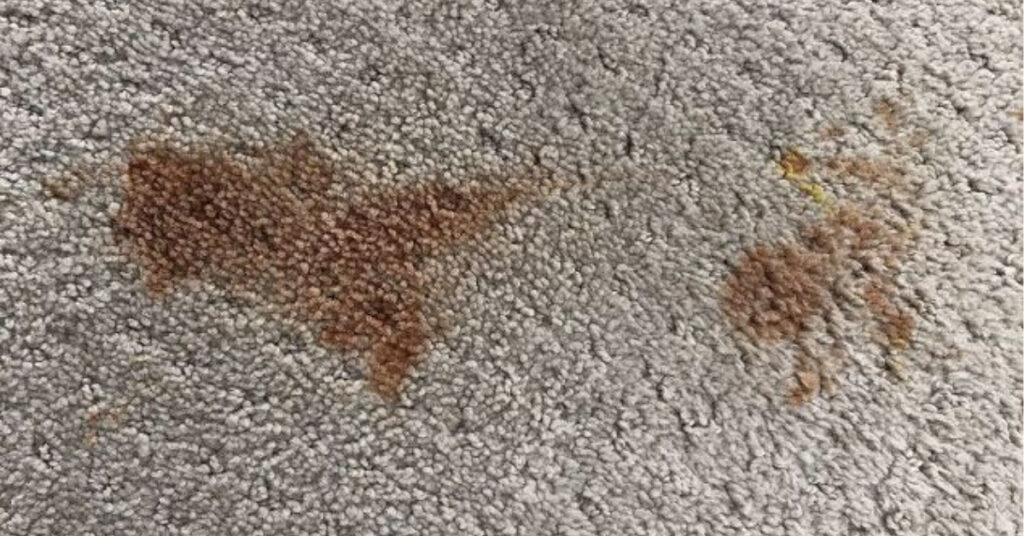
Oil stains can feel like a lost cause, but the right steps can bring your carpet back. Act fast, use the right tools, and skip the rookie mistakes, and you’ll seal the deal. Whether you like DIY or the no-fuss route of calling in a cleaner, being consistent and paying attention to detail will keep those tricky stains from winning.
FAQs
Can old oil stains be removed from carpet?
Yes! Old oil stains are more stubborn but not impossible. You’ll need to rehydrate the stain with warm water, apply baking soda, and follow up with dish soap or commercial cleaner. Multiple treatments may be necessary, but persistence pays off.
What household products work best for oil stains?
Baking soda, cornstarch, white vinegar, and dish soap are your best friends for oil stain removal. They’re natural, safe, and effective for most household carpets.
Is it safe to use vinegar on oil-stained carpet?
Yes, especially white distilled vinegar. It not only helps break down oil but also combats odors. Try mixing vinegar with water and applying it after using baking soda for a powerful combination. Always spot-test on a hidden area first.
How long should I leave baking soda on an oil stain?
For fresh spills, 15–20 minutes is usually sufficient, but for older or heavier stains, letting the powder sit for several hours or overnight can increase absorption. The longer it sits, the more oil it can draw out.
Will professional carpet cleaning remove oil stains completely?
In most cases, yes. Professionals use specialized degreasers and extraction equipment that can handle even deep-set stains. If you’ve tried DIY and commercial methods without success, hiring a pro is a worthwhile investment.
Additional Tip: How can I stop oil stains from happening in the first place?
You can definitely make it easier. Lay down rugs or mats in spill-prone spots, like under the kitchen table or at the workbench. If something does spill, blot it right away. Keeping a bag of absorbent powder, like cornstarch or baking soda, nearby means you can soak up a mess in a hurry.
As an Amazon Associate, I earn from qualifying purchases.

